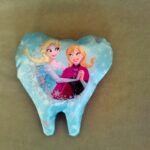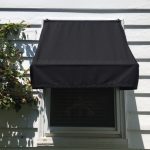Sometimes you get an idea for something and it takes off. That’s what happened to Laurie Carty. One day, she was looking online for purses and stumbled upon a crocheted fat bottom bag. She instantly fell in love with the classic hippie-style purse and thought the design and shape of the bag would look great in denim. Unable to find her dream bag in stores or online, Laurie set out to sew her own. What started as a purse for herself has now grown into a small business. Using her Sailrite® Ultrafeed®, she’s reintroducing these vintage-style bags to the world and reigniting her love of sewing.
The Start of an Idea
Laurie was excited to jump in and get going on her purse. She already had some basic sewing skills, so she knew she’d be able to sew the purse without a problem. However, she hit a speed bump early on. She didn’t know anything about pattern making or purse design. And since she couldn’t find a pattern for a denim flat bottom purse online, she needed a little help designing and patterning her purse. Luckily, her sister was coming for a visit. An accomplished seamstress, Laurie’s sister was able to help with the design process.
“I drew out my idea and we created the pattern together. Once I saw my dream come to reality, I was hooked! I got so many compliments on my purse that I started taking orders for them. For the most part, all the purses that I have sold have been local. Women stop me on the street and ask me where I got my purse. They are always surprised when I tell them I made it myself!”

Laurie’s first purse made from an old pair of jeans and a bedsheet on her home sewing machine, before she upgraded to an Ultrafeed.
After that initial design, Laurie added fringe and beads to her bags as unique design elements. Since her fat bottom bags were inspired by the hippie era, the fringe fit right in with that style and aesthetic. “When I was in my teens and twenties, everything was fringe. I am 62 now, but back in the day, I was a complete hippie — with the clothes and hair. Everything was tie-dye and fringe, and we did it ourselves for the most part.”
Laurie upcycles used jeans that are still in good condition for her purses. She adds fabric panels, lace, beads and fringe to create truly one-of-a-kind designs. “I love every single one of the purses that I create. Each one has its own unique beauty.”
Finding Her Creative Process
Laurie lets her creative spirit guide her not only in her bag designs but in life too. A self-professed “avid student and seeker of personal change,” Laurie has a degree in behavioral sciences. She’s helped people with therapeutic stress and trauma relief, she’s taught dance classes and has even been a radio show host. “I’ve had a pretty crazy life!”
Laurie has always had a creative spirit. One of the things she loves the most about the DIY lifestyle is her ability to bring her dreams and ideas to life in a tangible way. She loves the process of taking an idea, a vision in her mind, and using fabric and thread to bring her idea to life. “Every purse I make I see fully completed in my mind, and then I know exactly how to create it. I have always been a very visually creative person. My brand-new idea is brought into reality, and now I am the only one on the planet who makes these bags. Every purse is uniquely different.”

Upgrading to an Ultrafeed
After completing her first two bags, her regular sewing machine was struggling to sew through the thick layers of denim. Laurie knew she’d need a heavy-duty machine capable of handling multiple layers of thick material. That’s how she found Sailrite. “I knew I needed something stronger and started searching the internet. I had never used an industrial machine before. In fact, I would not say I knew that much about sewing, really, but your videos made everything so easy to understand. I love that you also have troubleshooting videos on your site, which made it so easy to learn the machine.”
Her Ultrafeed has given Laurie the confidence to attempt sewing projects she previously had never dreamed of. Not only does she sew her hippie bags, but she is also branching out into projects for her husband’s motorcycle. “I have lined my husband’s riding chaps that he wears on his motorcycle and made a cover for his oil cooler on his Harley. I’m not afraid to tackle anything anymore!”
Laurie’s Etsy shop, The Hippie Handbag Company, is a nod to her love of all things 1960s, especially the hippie lifestyle. “I grew up in that era. I was a little too young to go to the original Woodstock, but it was all about the lifestyle back then. It was a very creative time in so many ways — music, peace, love, rock ‘n’ roll, the hair, the dress styles. Upcycling was big back then too. It represented unique and individual creativity and expression. Just like my bags, every person is different and beautiful in their own way.”
Whether you were alive during that era or just have a fondness for all things boho, Laurie’s life philosophy is something we can all appreciate.
Who We Are
Sailrite is your one-stop DIY shop! We are a passionate crew of do-it-yourselfers who strive to equip you with the supplies and how-to knowledge you need to tackle your next project. Do you want to learn upholstery, leatherwork, canvaswork, hobby sewing, bag making or more? We have the fabric, tools, hardware, sewing machines and notions you need to master any DIY. And even if you’ve never sewn before, our tutorials and how-to videos are designed for beginners and experienced crafters alike.
Start your DIY journey today: www.sailrite.com





















































